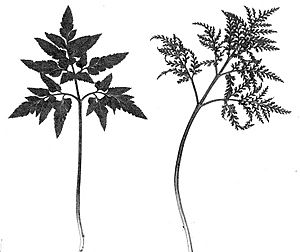Sceptridium dissectum facts for kids
Quick facts for kids Sceptridium dissectum |
|
|---|---|
 |
|
| Conservation status | |
| Scientific classification | |
| Genus: |
Sceptridium
|
| Species: |
dissectum
|
| Synonyms | |
|
|
Sceptridium dissectum is a common fern found in eastern North America. It belongs to a plant family called Ophioglossaceae. This fern is also known as the cutleaf grape fern because its spore-producing parts look like a bunch of grapes.
Like other plants in its group, it usually grows only one leaf, called a frond, each year. This fern can look different depending on its form. One form looks like other ferns in its family, while the other looks more "skeletonized" or lacy.
The cutleaf grape fern is very common in many areas. It often grows in places where the land has been disturbed, like open fields or along paths. It has a unique growing season. New fronds appear in July and stay green through the winter. They often turn a bronze color before dying back in May.
Like other grape ferns, it needs a special partnership with fungi in the soil. This partnership is called a mycorrhizal association. The fungi help the fern get nutrients from the soil.
Contents
About the Cutleaf Grape Fern
The cutleaf grape fern, Sceptridium dissectum, has two main parts that look like separate leaves. One part is the fertile frond, which looks like a stalk of grapes. This is where the fern makes its spores. The other part is the sterile frond, which looks like a regular leafy fern blade.
The leaves of Sceptridium dissectum are a light green color. They usually stay green for most of the year, even through winter. In the summer, some of the leaves might fall off, but others stay green. The grape-like parts that hold the spores, called sporangia, can be green or yellow. The stem of the plant is green from top to bottom and smooth.
The sterile frond, or leaf, is mostly divided into many small sections, making it look very lacy. The fertile stalk is connected to the stem of the sterile leaf blade close to the ground. The entire plant usually stands about six to fifteen inches tall.
How to Identify the Cutleaf Grape Fern
Sometimes, the cutleaf grape fern can be mistaken for another fern called the rattlesnake fern, Botrypus virginianus. However, there are a few ways to tell them apart.
- Size: The rattlesnake fern can grow up to two feet tall, which is much taller than the cutleaf grape fern, which is usually only about a foot tall.
- Stem Color: The stem of the cutleaf grape fern is light green. The rattlesnake fern, however, has a pinkish stem at its base.
- Spore Parts: The rattlesnake fern's sporangia look like a rattlesnake's tail, while the cutleaf grape fern's sporangia look like grapes.
The cutleaf grape fern is also related to the Southern Grapefern, Botrychium biternatum. All these ferns belong to the Ophioglossales order and the Ophioglossaceae family, which is also known as the Adder’s tongue family.
The scientific name Sceptridium dissectum (Spreng.) Lyon was given to this fern in 1905. Before that, it was known as Botrychium dissectum Spreng. It has also been called by several other names over the years, showing how scientists have studied and classified it.
Where Does the Cutleaf Grape Fern Live?
The cutleaf grape fern grows across a wide area in the USA. You can find it from Minnesota in the west, south to northeastern Texas, and all along the east coast.
This fern likes to live in different kinds of places. It can be found in woodlands, sandy grasslands, and along the edges of swamps or ravines. It especially likes deciduous forests, which are forests where trees lose their leaves in the fall. In these forests, the cutleaf grape fern can get sunlight during the winter when the trees have no leaves.
Life Cycle of the Cutleaf Grape Fern
The cutleaf grape fern is a homosporous fern. This means it produces only one type of spore. It is also a perennial plant, which means it lives for many years.
This fern usually grows best in partial sunlight to medium shade. For soil, it prefers loam or sandy loam that is moist to slightly dry. The cutleaf grape fern takes a long time to grow from its spores. It relies heavily on a special type of fungi, called mycorrhizal fungi, to survive.
For the spores to start growing, they need to be in complete darkness for about 3 to 4 weeks. The longer the spores stay in the dark, the better their chances of germination (starting to grow). Even after the fern's leaves appear, it still depends on these fungi.
Unlike some other ferns in its family, the cutleaf grape fern does not always produce spores every year. It typically grows only one leaf per year. It is believed that the cutleaf grape fern can live for a very long time, possibly between 10 and 45 years! Because it is so difficult to grow from spores, it is rarely grown in gardens. While it is common in most places, it is listed as an endangered plant in New York.
Who Eats the Cutleaf Grape Fern?
The leaves of the cutleaf grape fern are a food source for some animals. Wild turkeys and ruffed grouse, which are types of birds, eat its leaves. White-tailed deer also feed on this fern.



